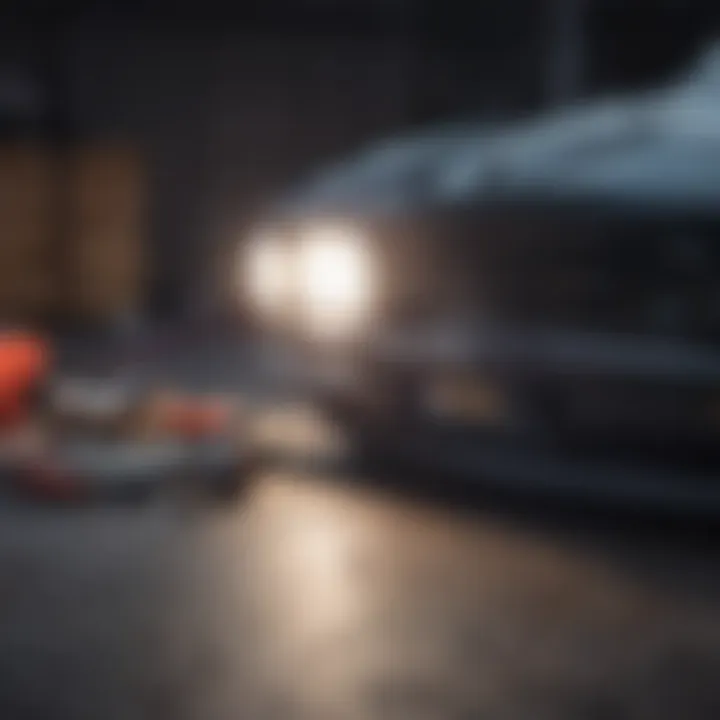A Comprehensive Guide to Changing Vehicle Headlights


Intro
Changing headlights is an essential part of vehicle maintenance, though it often goes unnoticed. Many drivers do not fully understand the importance of having adequate lighting. This guide will provide crucial information on how to effectively change vehicle headlights, what types are available, and necessary steps for the process. Understanding the different kinds of headlights and their functionality is vital for both safety and compliance with automotive standards.
Types of Headlights
Before diving into the process of changing headlights, it is important to familiarize yourself with various types of headlights available:
- Halogen Headlights: These are the most common type found in vehicles. They are inexpensive and provide good visibility but have a shorter lifespan compared to other options.
- Xenon (HID) Headlights: Known for their bright, white light, Xenon headlights produce more light than halogen. However, they tend to be more expensive and may require additional components for installation.
- LED Headlights: These are the newest technology offering the longest lifespan and energy efficiency. They provide excellent visibility and are becoming increasingly popular in modern vehicles.
Understanding the differences is not just for educational purposes. The type of headlights your vehicle requires will influence the process of changing them.
Importance of Proper Lighting
Proper lighting is not merely an aesthetic choice but a safety necessity. The right headlights enhance your visibility on the road, allowing you, as a driver, to see potential hazards clearly. Furthermore, good headlights ensure that others can see your vehicle. Inadequate lighting can lead to dangerous situations, especially during night driving or inclement weather.
Safety Tip: Regularly check your headlights to ensure they are functioning. Replacing dim or burnt-out bulbs promptly will not only improve your visibility but also maintain compliance with safety regulations.
Changing Headlights: Step-by-Step Instructions
Here, we will detail the various steps involved in changing your vehicle's headlights. This process can vary depending on the make and model of your vehicle, so consulting the manual is always advisable.
- Gather Necessary Tools: Typically, you will need basic tools like a screwdriver and, in some cases, gloves to protect your hands.
- Access the Headlight Compartment: Open the hood and locate the headlight compartment, which is usually situated at the front of the vehicle.
- Remove the Old Headlight Bulb: Carefully disconnect the old bulb. Depending on the mechanism, this may involve twisting or unclipping it.
- Install the New Headlight Bulb: Handle the new bulb with care, avoiding touching the glass part. Insert it into the socket, ensuring it is secure.
- Test the New Bulb: Before you close the hood, turn on the headlights to make sure the new bulb is functioning correctly.
- Close Everything Up: Once confirmed, put everything back in place.
Recommended Tools
For changing headlights effectively, consider keeping the following tools handy:
- Screwdrivers (flat and Phillips)
- Gloves (to handle bulbs)
- Clean cloth (for wiping surfaces and bulbs)
Consistently having the right tools can streamline the process, making it less time-consuming and more efficient.
Common Issues When Changing Headlights
Even with careful planning, some issues may arise:
- Incorrect Bulb Fit: Ensure that the bulb matches your vehicle’s specifications.
- Electrical Issues: Sometimes issues stem from electrical problems rather than the bulbs themselves.
- Fogging: If the headlight housing is fogged, consider cleaning or replacing it for improved illumination.
Closure
Changing headlights is a straightforward task but can significantly enhance your driving experience. By understanding the types of headlights, their importance, and taking the right steps, vehicle owners can ensure safe and compliant lighting. Remember to maintain and regularly check your headlights for safety.
Prologue to Vehicle Headlights
Understanding vehicle headlights is essential for any car owner or enthusiast. Headlights illuminate the road ahead, ensuring a safer driving experience, especially at night or in adverse weather conditions. They also affect how other drivers perceive your vehicle. Properly functioning headlights can increase visibility, decreasing the risk of accidents.
In this section, we will explore the role of headlights in vehicle safety and the different technologies available. Knowing the choices you have for headlights is vital for making informed decisions. It also ensures compliance with local laws and regulations regarding vehicle lighting.
Understanding the Role of Headlights
The primary function of headlights is to provide illumination to the driver during low-light conditions. They help in detecting any obstacles on the road, making night driving safer. Additionally, headlights serve as a means of communication with other road users. Brightness and position of headlights can signal a vehicle's presence to pedestrians and other motorists.
Effective headlights can have a significant impact on driving performance. Poor lighting can lead to suboptimal visibility, which increases the likelihood of accidents. Thus, understanding how headlights work contributes to overall road safety.
Types of Headlight Technologies
Headlight technology has evolved dramatically over the years. There are three main types of headlights generally used in vehicles: Halogen headlights, LED headlights, and HID (Xenon) headlights. Each technology offers unique benefits and considerations.
Halogen Headlights
Halogen headlights are the most common type of headlight found in many vehicles. They use a filament that produces light when an electric current passes through it. One of the key characteristics of halogen headlights is their cost-effectiveness. They are usually less expensive when compared to other types of headlights.


The unique feature of halogen headlights is that they provide a warm yellowish light, which some drivers prefer because it can reduce glare for oncoming traffic. However, halogen bulbs have a shorter lifespan than newer technologies, typically lasting about 500 to 1,000 hours. This can be a disadvantage if you desire longevity and energy efficiency.
LED Headlights
LED headlights are gaining popularity due to their efficiency and longer lifespan. The key characteristic of LED headlights is their ability to produce brighter light with less energy consumption. They can last up to 25,000 hours or more, which means fewer replacements over time.
One unique feature of LED technology is the ability to create various light colors, allowing customization to some extent. However, LED headlights can be more expensive to purchase and install than halogen headlights. The initial investment may be higher, but long-term savings in replacements and increased visibility can offset these costs, making it a sound choice for many drivers.
HID (Xenon) Headlights
HID headlights, commonly known as Xenon headlights, are another alternative in modern vehicles. They produce light by using high voltage to create an electrical arc between two electrodes. A key characteristic of HID headlights is their brightness, which can be significantly higher than halogen and LED options. This makes them an attractive choice for night driving.
A unique feature of HID lights is their distinctive blue tint, which many drivers find appealing. However, they require special fixtures, and compatibility can sometimes be an issue with older vehicle models. Additionally, while they produce excellent illumination, HID headlights can create glare for oncoming traffic if not properly aligned.
Knowing the pros and cons of each type of headlight technology allows vehicle owners to make informed choices. The right headlights can improve safety, reduce energy consumption, and enhance overall driving experience.
"Understanding headlight types is key to ensuring safe and effective illumination on the road."
In the following sections, we will continue to explore important factors regarding headlight functionality, maintenance, and the processes involved in changing headlights.
Importance of Headlight Functionality
Headlights play a crucial role in ensuring safe driving conditions. They illuminate the road ahead during night-time and in adverse weather conditions, allowing drivers to see potential hazards. This section elaborates on the significance of having fully functional headlights, addressing visibility concerns and legal standards that govern vehicle lighting.
Impact on Visibility
Visibility is perhaps the most critical function of vehicle headlights. During nighttime driving or inclement weather, headlights provide the necessary light to see and be seen by others. Poorly functioning headlights directly affect a driver’s ability to react to obstacles, pedestrians, or other vehicles in time. Studies show that about 50% of accidents occur after dark. As such, ensuring optimal headlight performance can significantly reduce the risk of collisions.
Proper alignment of headlights is another aspect that affects visibility. Misaligned headlights can cause the light beam to point in the wrong direction, failing to illuminate the road effectively. This not only endangers the driver and passengers but also puts other road users at risk of accidents. Regular headlight maintenance and timely replacement of faulty bulbs can vastly improve night-time visibility.
Legal Requirements
In addition to safety, there are also legal implications associated with headlight functionality. Many regions have strict regulations regarding vehicle illumination. These laws dictate the types of lights permitted, their brightness, and how they should be positioned relative to the road. For instance, using high beams in oncoming traffic can cause severe glare, prompting legal penalties.
Driving with non-functional headlights can lead to traffic fines or points on a driver's license. Furthermore, in some jurisdictions, failing to maintain operational headlights may void vehicle insurance claims following an accident. Familiarizing oneself with local regulations regarding vehicle lighting is essential for every vehicle owner.
"Headlight functionality is not just about illumination. It is a fundamental legal requirement that impacts road safety significantly."
In summary, the functionality of headlights serves two primary purposes: ensuring the driver's visibility in various conditions and complying with legal standards that protect all road users. Proper attention to headlight maintenance is not just a best practice but a vital aspect of responsible vehicle ownership.
When to Change Your Headlights
Determining the right moment to change your vehicle’s headlights is crucial for maintaining optimal visibility and safety on the road. This section delves into two key aspects that signal the need for a headlight replacement: identifying dim or flickering lights and understanding the lifespan of the bulbs. Recognizing these indicators will not only improve your driving experience but also ensure compliance with legal requirements related to vehicle lighting.
Identifying Dim or Flickering Lights
Dim or flickering headlights can be a warning sign that something is amiss. Dim lights may occur gradually, making it easy to overlook until it becomes noticeable. Insufficient brightness can hamper visibility, particularly during nighttime driving or in poor weather conditions. The following points highlight the signs of dim or flickering lights:
- Dimming: If you notice that your headlights are casting less light than usual, or if they appear yellowish or cloudy, it may be time for a change.
- Flickering: If your headlights flicker or turn off intermittently, check the connections and consider replacing the bulb. Flickering can indicate an electrical issue as well.
Understanding Bulb Lifespan
Every headlight bulb has a specific lifespan, which is a critical factor in knowing when to change them. Various types of bulbs have different longevity:
- Halogen Headlights: Typically last between 450 to 1,000 hours. These are the most common but tend to burn out more frequently.
- LED Headlights: Known for their long lifespan, they can last approximately 25,000 to 50,000 hours. This makes them a favored choice among vehicle owners.
- HID (Xenon) Headlights: These bulbs have a lifespan of about 2,000 hours and offer bright illumination, but may require replacement over time as well.
Understanding these lifespans helps you plan ahead. If your bulbs are nearing the end of their life cycle, replacing them proactively can prevent surprise outages. It also ensures better visibility during critical driving times. Adopt a regular inspection schedule to track bulb performance and detect issues early. This way, you can maintain safe driving conditions and ensure your headlights function optimally.
Tools Required for Changing Headlights
Changing your vehicle's headlights is not only a task of necessity but also one that requires the right tools for effectiveness and ease. Using the appropriate tools can simplify the process, saving time and reducing the risk of damage to both the vehicle and the new headlights. Each tool serves a purpose essential to the steps outlined in this guide. Understanding the tools required will facilitate a smoother experience when approaching the task of changing headlights. Now, let's explore the basic tools and some optional ones that may enhance your ability to work on your vehicle safely and efficiently.


Basic Tools List
Screwdriver
A screwdriver is an invaluable tool when it comes to changing headlights. This tool is often necessary to access the headlight assembly, as many vehicles require screws to be removed before you can reach the bulbs. A good quality screwdriver makes the process more efficient. When selecting a screwdriver, it is best to choose one that fits the screws in your vehicle perfectly; this prevents stripping the screw heads.
Screwdrivers come in various types, including flathead and Phillips. The versatility of a Phillips screwdriver makes it a popular choice in the automotive field due to its ability to provide grip while turning the screws. A unique feature is its cross-shaped tip, which allows for better torque application. Though it's a straightforward tool, not having the right size screwdriver can lead to frustration when trying to change headlights.
Gloves
Wearing gloves during the headlight replacement process is smart and safe. Gloves serve to protect your hands from sharp edges and potentially harmful substances present in the vehicle. One key characteristic of gloves is their ability to provide a good grip, ensuring that you can handle tools and components without dropping them.
Choosing gloves made of a durable yet flexible material can enhance your dexterity. This allows for precise movement while working on intricate parts of the headlight assembly. Handling the new bulbs carefully is essential since oils from your skin can damage them, leading to a shorter lifespan. Thus, gloves are not merely protective equipment; they also contribute positively to the overall effectiveness of changing headlights.
Torpedo Level
Using a torpedo level may not seem essential at first glance, but it can significantly contribute to the proper adjustment of headlights once they're installed. This tool is designed to verify that the headlights are aimed correctly, ensuring that your new bulbs provide optimum illumination. The key characteristic of a torpedo level is its compact size, which allows it to fit in tight spaces.
A unique feature of many torpedo levels is their magnetic base, which can be adhered to metal surfaces for hands-free use. Ensuring headlights are level not only promotes better visibility on the road but also aligns with legal lighting standards. Using this tool could prevent accidents caused by misaligned beams that may blind other drivers or fail to illuminate the road adequately.
Optional Tools for Enhanced Access
Pliers
Pliers can be an excellent supplemental tool when changing headlights. While not always necessary, they can assist in gripping or maneuvering components that are otherwise hard to reach. The main advantage is that pliers allow for a firm grasp, making it easier to twist wires or pull out stubborn connectors.
Different types of pliers, such as needle-nose pliers, may provide access to tight spaces. One must keep in mind their potential hazards; careless use could lead to damage to wires or connectors. However, when handled properly, pliers can be very beneficial for tasks involving delicate connections.
Flashlight
A flashlight is a basic yet incredibly useful tool during the headlight replacement process. Often, the work area may lack sufficient lighting, making visibility an issue. A flashlight ensures that you can see what you are doing, especially when working in dark or cramped spaces underneath the hood.
Using an LED flashlight can provide brighter and more focused light, which helps in clearly viewing the headlight assembly. The compact size of a flashlight often allows for easy handling. However, it's crucial to ensure that your flashlight has a reliable battery, as a dead flashlight in the middle of the job could cause setbacks.
Conclusion: Each of these tools plays an important role in effectively changing headlights. While the basic tools get the job done, optional tools like pliers and a flashlight enhance accessibility and visibility, making the entire replacement process smoother.
Step-by-Step Process for Changing Headlights
Changing headlights is a task that, while straightforward, requires attention to detail and an understanding of the specific components involved. An effective approach will ensure that the headlights are not only replaced correctly but will also function optimally. This section outlines a systematic process, breaking down each phase to promote safety and efficiency.
Preparation and Safety Measures
Before proceeding with the replacement, it’s essential to gather necessary tools and ensure safety. Start by parking your vehicle on a flat surface, away from traffic. Turn off the vehicle and engage the parking brake. If possible, disconnect the battery to avoid any electrical mishaps. Equip yourself with gloves and goggles to protect against any debris or accidental bulb breakage. Moreover, wearing old clothing is advisable, as the process may involve grease or dirt.
Accessing the Headlight Assembly
To access the headlight assembly, open the vehicle’s hood and locate the rear cover of the headlights. Depending on the make and model, you might need to remove screws or clips holding the cover in place. Take care when handling these components, as they can be delicate. If your vehicle has tight spaces, sometimes removing other parts like the battery or air intake can offer better access.
Removing the Old Headlight Bulb
With access achieved, the next step involves taking out the old bulb. First, locate the bulb holder which usually requires turning or pulling. Some bulbs are held in place by a spring mechanism, while others might simply twist out. Be cautious during this step; gently twist the bulb to avoid breakage. If the bulb is stuck, applying a little lubricant can help free it up.
Installing the New Headlight Bulb
When installing the new bulb, handle it with care. Touching the glass part of the bulb with your bare hands can leave oils that cause premature burning. Instead, hold the bulb by its base. Carefully insert the new bulb into the socket, ensuring it is positioned correctly. Depending on the type of bulb, you may need to twist it to lock in place. Check the manual for precise instructions related to your specific vehicle model.
Testing the New Headlight
After installation, it is crucial to test the newly installed bulb. Reconnect the battery if it was disconnected earlier. Turn on the headlights and ensure both the low and high beams function as intended. Observing the light pattern against a wall can help assess if the headlight is aligned correctly. If one side seems dimmer, adjustments may be necessary. To optimize safety, get a trusted employee or friend to check the brightness while you remain inside the vehicle.
Remember: Regularly checking the alignment and functionality of your headlights is essential for both safety and compliance with road regulations.


By following these steps meticulously, one can effectively replace vehicle headlights, significantly impacting driving safety and visibility.
Common Issues While Changing Headlights
Changing headlights may seem straightforward, but various issues can arise during the process. Understanding these common problems is crucial for ensuring a successful headlight replacement. Addressing compatibility and electrical issues not only enhances your safety on the road but also helps to avoid further vehicle damage. This section will explore potential challenges faced during headlight changes and offer insights to overcome them.
Compatibility Problems
Compatibility issues can lead to significant frustration when changing headlights. The first step is to ensure you have the correct bulb type for your vehicle. Not all bulbs fit every socket, so confirming the exact specifications is vital. Refer to your vehicle’s manual or consult resource sites like Wikipedia to ascertain the right bulb type.
Moreover, it's important to be aware of automotive systems that may have changed over time. For instance, newer models might be equipped with advanced lighting technologies, such as LED or HID. If you try to install a halogen bulb in a vehicle designed for LED, it simply won't work.
To prevent these mismatches:
- Check the OEM Specifications: Always purchase bulbs that meet original equipment manufacturer (OEM) standards.
- Compare Models: If modifying the headlights or using aftermarket parts, ensure compatibility with vehicle makes and models to avert installation delays.
When in doubt, contacting your local dealership or a trusted mechanic can also help clear any confusion regarding compatibility issues.
Electrical Failures
Electrical issues present another layer of complexity when changing headlights. These difficulties often manifest as flickering lights or complete bulb failure, even after fresh installation. The first line of inquiry should focus on the vehicle's wiring. A worn-out connection can lead to intermittent power, affecting new bulbs.
Here are some typical signs and their underlying causes:
- Flickering Headlights: This could indicate a loose or corroded wiring connection.
- Bulb Burnout: Replacing a bulb and experiencing immediate failure might mean there's an electrical short somewhere in the circuit.
To diagnose these problems, follow these steps:
- Inspect Wiring: Look for frayed wires or loose connections.
- Check Fuses: A blown fuse can disrupt power supply to the headlights.
- Test Voltage: Use a multimeter to test the voltage reaching the headlight socket.
Being aware of these common issues can save time on the repair process. If electrical problems persist, consulting a professional is advisable. DIY solutions can often lead to further complications if not carefully handled.
Maintenance Tips for Headlights
Maintaining your vehicle's headlights is crucial to ensure they perform optimally over time. Well-functioning headlights improve visibility, especially at night or in poor weather conditions. Regular maintenance prevents dimming and enhances driver safety. Additionally, compliance with legal standards is essential for road usage. This section will explore two primary aspects of headlight maintenance: cleaning techniques and regular inspection protocols.
Cleaning Techniques
Cleaning your headlights is a straightforward yet effective way to enhance their performance. Over time, dirt, bugs, and road grime accumulate on the headlight lenses, leading to reduced light output. Here are some effective methods for cleaning your headlights:
- Soap and Water: Start with a simple mix of soap and warm water. Use a microfiber cloth to gently scrub the lens. This method is great for light cleaning.
- Baking Soda Paste: For tougher stains, mix baking soda with water to create a paste. Apply it to the headlight and scrub gently with a cloth or sponge. Baking soda acts as a mild abrasive, removing grime without scratching the surface.
- Vinegar Solution: Another natural and effective cleaner is a mixture of vinegar and water. Apply it with a soft cloth to clear cloudiness and restore clarity.
- Commercial Headlight Cleaners: Many automotive suppliers offer specific headlight cleaning products. These often include specialized polish designed to remove oxidation.
Note: After cleaning, applying a UV protectant can help shield the lens from future damage.
Regular Inspection Protocols
Routine inspections of your headlights should be part of regular vehicle maintenance. Identifying potential issues early can save you from costly replacements and improve safety on the road. Below are steps to implement a robust inspection routine:
- Schedule Regular Checks: Make it a habit to inspect your headlights at least once every few months. Look for signs of fading, cracks, or moisture inside the housing.
- Check Alignment: Misaligned headlights can impair visibility and dazzle oncoming drivers. Ensure that they are correctly positioned. If they are not, consider adjusting them according to your vehicle's manual.
- Bulb Condition: Look for any dimming or flickering. This could signal that the bulb is nearing the end of its lifespan.
- Wiring and Connections: Check for loose or damaged wiring around the headlight assembly. Poor connections can lead to electrical failures, impacting headlight performance.
By implementing these cleaning techniques and inspection protocols, vehicle owners can extend the life of their headlights while ensuring optimal safety and visibility on the roads.
Finale
In this guide, we have traversed the essential aspects of changing vehicle headlights. Headlights serve not only to illuminate our route but also to ensure safety on the roads. Recognizing their importance goes beyond mere functionality; it encompasses compliance with legal standards and the need for optimal visibility in varying driving conditions.
Recap of Importance
The importance of functioning headlights cannot be understated. They directly influence visibility, which is critical while driving, especially at night or in poor weather. A dim or malfunctioning headlight increases the risk of accidents. Additionally, many regions enforce legal requirements regarding headlight functionality. Maintaining headlights can prevent costly fines and ensure compliance with these regulations.
Furthermore, understanding the types of headlights available, such as Halogen, LED, and HID, allows vehicle owners to make informed decisions when replacing burnt-out bulbs. Each type has unique benefits and lifespan, directly impacting the driving experience.
Final Recommendations
To maintain effective headlights, regular inspections and cleaning should be part of routine vehicle care. Here are some key recommendations:
- Inspect headlights regularly for clarity and brightness.
- Clean them frequently to remove dirt and debris, which can obscure light output.
- Replace them in pairs to ensure balanced lighting. This avoids having one brighter than the other, which can be distracting.
- Follow proper procedures during installation, ensuring bulbs are correctly seated to prevent damage.
- Choose high-quality bulbs that match your vehicle's specifications.
By adhering to these practices, vehicle owners not only enhance their safety but also prolong the life of their headlights. Proper illumination is a fundamental aspect of vehicle maintenance that merits serious consideration.



